Bus Tour Two
Comment via blog
Prev
Next


|
Day 9: June 21, 2019 Bus Tour Two Comment via blog |
Prev Next |
 
|
|
|

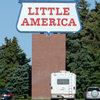 Our first stop on the western bus tour was at
Little America.
It is now a chain with multiple locations but this is the flagship
operation and as close to the original as one can get. Taking its name
from Admiral Byrd's 1929 camp in Antarctica, the first Little America
one-stop was opened in 1934 near Granger, Wyoming, by Stephen Covey. After
it burned to the ground in 1948, this one was opened around 1950.
Presumedly to connect with Admiral Byrd and to contrast with the palm
trees he'd inexplicably brought to Wyoming, Covey arranged to have a live
penguin sent from Antarctica. It did not survive. The unlucky bird was
stuffed and sent on to Wyoming where it could satisfy Covey's promise of
"real penguins". It's still on the job today. The plaque at its
feet can be read here.
Our first stop on the western bus tour was at
Little America.
It is now a chain with multiple locations but this is the flagship
operation and as close to the original as one can get. Taking its name
from Admiral Byrd's 1929 camp in Antarctica, the first Little America
one-stop was opened in 1934 near Granger, Wyoming, by Stephen Covey. After
it burned to the ground in 1948, this one was opened around 1950.
Presumedly to connect with Admiral Byrd and to contrast with the palm
trees he'd inexplicably brought to Wyoming, Covey arranged to have a live
penguin sent from Antarctica. It did not survive. The unlucky bird was
stuffed and sent on to Wyoming where it could satisfy Covey's promise of
"real penguins". It's still on the job today. The plaque at its
feet can be read here.
|
|
|

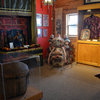


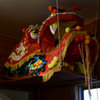 Stop number two was Evanston and it was a dandy with several sights and
activities. Right off the bus, we were presented with nice goody bags and
divided into three groups to rotate through three guided tours. My group
visited the Chinese Joss House first. Evanston was once home to a large
Chinese community that maintained a sizable Joss House that was destroyed
by fire in 1922. When this replica was built in 1990, many items that had
been in the original were returned. The dragon head is one of two made by
local students for use in celebrating Chinese New Year.
Stop number two was Evanston and it was a dandy with several sights and
activities. Right off the bus, we were presented with nice goody bags and
divided into three groups to rotate through three guided tours. My group
visited the Chinese Joss House first. Evanston was once home to a large
Chinese community that maintained a sizable Joss House that was destroyed
by fire in 1922. When this replica was built in 1990, many items that had
been in the original were returned. The dragon head is one of two made by
local students for use in celebrating Chinese New Year.
|
|
|

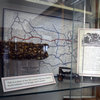

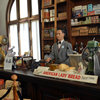
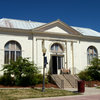 The first rotation took me to the Uinta County Museum. Among the displays
is one on the Lincoln Highway that includes a piece of Lincoln Highway
pavement from near Fort Bridger and evidence that self-service fueling
really was pretty risky in the past.
The first rotation took me to the Uinta County Museum. Among the displays
is one on the Lincoln Highway that includes a piece of Lincoln Highway
pavement from near Fort Bridger and evidence that self-service fueling
really was pretty risky in the past.
|
|
|
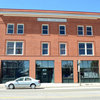
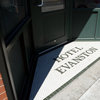
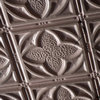

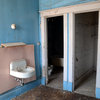
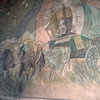 Next up was the 1912 Hotel Evanston. The hotel operated into the 1980s but
sat empty for several years and is now owned by the Evanston Urban Renewal
Agency. Restoring the building is clearly a monumental task, but Evanston
has undertaken monumental tasks before.
Next up was the 1912 Hotel Evanston. The hotel operated into the 1980s but
sat empty for several years and is now owned by the Evanston Urban Renewal
Agency. Restoring the building is clearly a monumental task, but Evanston
has undertaken monumental tasks before.
|
|
|
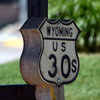
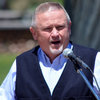

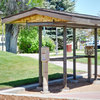 After we had all finished our three tours, it was time to dedicate a pair
of markers. Shelly Horne, who was one of the step-on guide when our buses
entered Evanston, introduced Mayor Kent Williams and handled the
dedication. One of the markers was a concrete 1928 Lincoln Highway marker
and the other a concrete US-30S marker from the 1930s. I don't recall ever
seeing a concrete marker for any US highway. Apparently markers like this
one were placed approximately ten miles apart and in the vicinity of a
concrete Lincoln Highway marker. US-30S was the sothern component of a
split route running between Granger, Wyoming, and Burley, Idaho.
plaques are ready for the Lincoln Highway
end of the shelter. Plaques for the US-30S end are in progress.
After we had all finished our three tours, it was time to dedicate a pair
of markers. Shelly Horne, who was one of the step-on guide when our buses
entered Evanston, introduced Mayor Kent Williams and handled the
dedication. One of the markers was a concrete 1928 Lincoln Highway marker
and the other a concrete US-30S marker from the 1930s. I don't recall ever
seeing a concrete marker for any US highway. Apparently markers like this
one were placed approximately ten miles apart and in the vicinity of a
concrete Lincoln Highway marker. US-30S was the sothern component of a
split route running between Granger, Wyoming, and Burley, Idaho.
plaques are ready for the Lincoln Highway
end of the shelter. Plaques for the US-30S end are in progress.
|
|
|
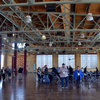
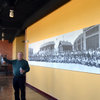
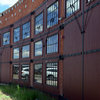
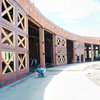

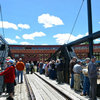 There was one more stop in Evanston but it was far enough from the others
that we rode the buses. They took us to lunch at the partially restored
roundhouse complex and, yes, that is a most impressive
door in the far corner. Jim Davis, the other bus
step-on guide, was also our guide at the roundhouse. The picture behind
him shows the 100% war bond participation of roundhouse employees.
Stepping outside, we could see that, while much restoration has been
accomplished, more is still in progress. Then we took a ride on the
turntable.
There was one more stop in Evanston but it was far enough from the others
that we rode the buses. They took us to lunch at the partially restored
roundhouse complex and, yes, that is a most impressive
door in the far corner. Jim Davis, the other bus
step-on guide, was also our guide at the roundhouse. The picture behind
him shows the 100% war bond participation of roundhouse employees.
Stepping outside, we could see that, while much restoration has been
accomplished, more is still in progress. Then we took a ride on the
turntable.
|
|
|

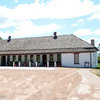
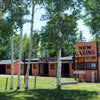

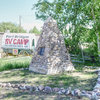
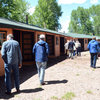 At Fort Bridger we quickly descended on the restored
Black and Orange Cabins. There were rumors that the pyramid out by the
road referenced the Lincoln Highway so many of us walked out to look it
over along with the nearby Jim Bridger statue. Cool pyramid but
no LH reference. Checking the pyramid did allow
time for the cabins to clear out. The grounds are beautiful and there are
several buildings to look over. There is a Lincoln Highway display (with a
touch of black and orange) inside the museum and a Pony Express
training simulator out
front.
At Fort Bridger we quickly descended on the restored
Black and Orange Cabins. There were rumors that the pyramid out by the
road referenced the Lincoln Highway so many of us walked out to look it
over along with the nearby Jim Bridger statue. Cool pyramid but
no LH reference. Checking the pyramid did allow
time for the cabins to clear out. The grounds are beautiful and there are
several buildings to look over. There is a Lincoln Highway display (with a
touch of black and orange) inside the museum and a Pony Express
training simulator out
front.
|
|
|
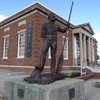

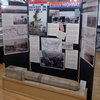
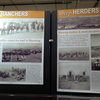

 The conference officially ended when the buses returned to the hotel but a
couple of optional activities remained. One was a visit to the
Sweetwater
County Historical Museum in Green River which stayed open late for our
benefit. The museum is celebrating the 150th anniversary of John Wesley
Powell's Colorado River expedition that began in Green River. There is a
Lincoln Highway exhibit and the attendant told me there had been a much
larger one for the centennial in 2012-13. The museum also features
ranchers, herders, miners, and those who came before.
The conference officially ended when the buses returned to the hotel but a
couple of optional activities remained. One was a visit to the
Sweetwater
County Historical Museum in Green River which stayed open late for our
benefit. The museum is celebrating the 150th anniversary of John Wesley
Powell's Colorado River expedition that began in Green River. There is a
Lincoln Highway exhibit and the attendant told me there had been a much
larger one for the centennial in 2012-13. The museum also features
ranchers, herders, miners, and those who came before.
|
|
|
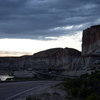
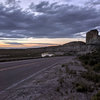
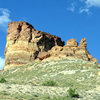
 When I left the museum, I slipped down by the river to grab a few pictures
of the iconic Palisades then behind some houses to get a clear view of
Castle Rock. Next came dinner at a local restaurant where many but not all
conference attendees gathered for one more meal together. As that was
winding down a few minutes before sunset, I decided to head back to the
Palisades to photograph the sun on the rock. Steve Rider joined me. We
arrived just a little too late. The sun was behind some low clouds and,
although there was some color in the sky, light on the rocks was already
fading.
When I left the museum, I slipped down by the river to grab a few pictures
of the iconic Palisades then behind some houses to get a clear view of
Castle Rock. Next came dinner at a local restaurant where many but not all
conference attendees gathered for one more meal together. As that was
winding down a few minutes before sunset, I decided to head back to the
Palisades to photograph the sun on the rock. Steve Rider joined me. We
arrived just a little too late. The sun was behind some low clouds and,
although there was some color in the sky, light on the rocks was already
fading.
|
|
|
| [Prev] [Site Home] [Trip Home] [Contact] [Next] |